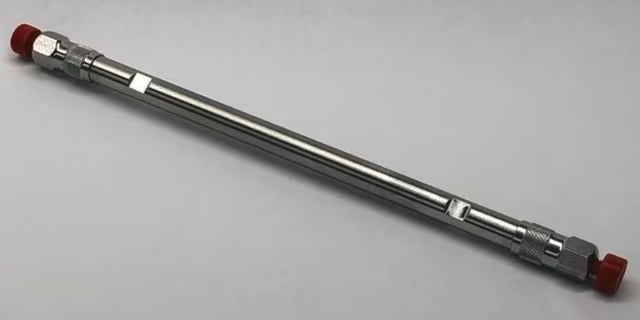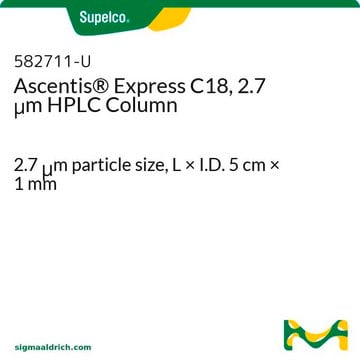Transportation information can be found in Section 14 of the product's (M)SDS.To access the shipping information for this material, use the link on the product detail page for the product.
54271-U
Ascentis® Express 90 Å C18 (2.7 μm) HPLC Columns
L × I.D. 15 cm × 300 μm HPLC Capillary Column
Sélectionner une taille de conditionnement
907,00 €
Sélectionner une taille de conditionnement
About This Item
907,00 €
Produits recommandés
Nom du produit
Ascentis® Express C18, 2.7 Micron Capillary HPLC Column, 2.7 μm particle size, L × I.D. 15 cm × 300 μm
Matériaux
stainless steel column
Agence
suitable for USP L1
Gamme de produits
Ascentis®
Caractéristiques
endcapped
Fabricant/nom de marque
Ascentis®
Conditionnement
1 ea of
Paramètres
400 bar pressure (5801 psi)
60 °C temp. range
Technique(s)
HPLC: suitable
LC/MS: suitable
UHPLC-MS: suitable
UHPLC: suitable
L × D.I.
15 cm × 300 μm
Superficie
135 m2/g
Impuretés
<5 ppm metals
Matrice
Fused-Core particle platform
superficially porous particle
Groupe de la matrice active
C18 (octadecyl) phase
Taille des particules
2.7 μm
Dimension de pores
90 Å pore size
pH de fonctionnement
2-9
Application(s)
food and beverages
Technique de séparation
reversed phase
Vous recherchez des produits similaires ? Visite Guide de comparaison des produits
Catégories apparentées
Produit(s) apparenté(s)
Faites votre choix parmi les versions les plus récentes :
Certificats d'analyse (COA)
Vous ne trouvez pas la bonne version ?
Si vous avez besoin d'une version particulière, vous pouvez rechercher un certificat spécifique par le numéro de lot.
Déjà en possession de ce produit ?
Retrouvez la documentation relative aux produits que vous avez récemment achetés dans la Bibliothèque de documents.
-
What is the Department of Transportation shipping information for this product?
1 answer-
Helpful?
-
-
Can I use Ascentis Express on a UHPLC system?
1 answer-
Yes. Ascentis Express columns are packed in a way making them suitable for these ultra high pressure instruments. In fact, Ascentis Express outperforms sub-2 μm micron columns on many applications since Ascentis Express provides the benefits of sub-2 μm particles but at much lower back pressure. These benefits include the capability of providing fast HPLC and higher resolution chromatography. The Fused-Core particle consists of a 1.7 μm solid core and a 0.5 μm porous shell. A major benefit of the Fused-Core particle is the small diffusion path (0.5 μm) compared to conventional fully porous particles. The shorter diffusion path reduces axial dispersion of solutes and minimizes peak broadening.
Helpful?
-
-
What is the pressure rating for 300 μm I.D. Ascentis® Express Capillary HPLC columns?
1 answer-
The 300 μm I.D. Ascentis® Express Capillary HPLC columns are stable to operating pressures up to 6500 psi.
Helpful?
-
-
What is the carbon load for Ascentis® Express C18 HPLC Columns?
1 answer-
Carbon load which is commonly referred to as %Carbon is misleading and not meaningful for Ascentis® Express. Since Fused-Core™ particle is unique in the sense that it has a solid core and porous shell, the %Carbon number can not be compared to traditional porous particles. The carbon coverage for Ascentis® Express C18 is 3.5 micromoles/meter-squared
Helpful?
-
Active Filters
Notre équipe de scientifiques dispose d'une expérience dans tous les secteurs de la recherche, notamment en sciences de la vie, science des matériaux, synthèse chimique, chromatographie, analyse et dans de nombreux autres domaines..
Contacter notre Service technique






